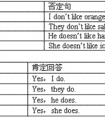句型转换:1. It's cold out side. I'll watch TV at home. I won't go out. (改为同义句) It's cold out side. I'll watch TV __________ __________ __________ -七年级英语
What have you been doing since? (构成完成进行体,本身无词义)
I am afraid I must be going. (一定要)
You may have read some account of the matter. (或许已经)
除此之外,情态助动词还有如下词法和句法特征:
1) 除ought和used以外,其他情态动词后面只能接不带to的不定式。如果我们把ought to和used to看做是固定词组的话,那么,所有情态动词无一例外地只能接不带to的不定式:
We used to grow beautiful roses.我们过去常常种这种漂亮的玫瑰花
I asked if he would come and repair my television set.我问他是否来修我的电视机
2) 情态助动词在限定动词词组总是位居第一:
They need not have been punished so severely.
3) 情态助动词用于第三人称单数现在时的时候,没有词形变化,即其词尾无-s形式:
She dare not say what she thinks.
4) 情态动词没有非限定形式,即没有不定式和分词形式,也没有相应的动名词:
Still,she needn't have run away.
5)情态助动词的“时”的形式并不是时间区别的主要标志。在不少场合,情态助动词的现在时和过去时形式都可以表示现在、过去或将来时间:
Would you mind very much if I ask you to do something?
She told him he ought not to have done it.
6) 情态助动词之间是相互排斥的,即在一个限定动词词组中只能出现一个情态助动词,但有时却可以与have和be基本助动词连用:
You should have washed the wound.
Well,you shouldn't be reading a novel.
7)情态动词must一般疑问句否定回答用needn't
Must I read books every day、
No,you needn't
常见情态动词用法:
1.can (could) 表示说话人能,可以,同意,准许,以及客观条件许可,could 为 can 的过去式。
2.Must 必须,应该,一定,准是,表示说话人认为有必要做某事,命令,要求别人做某事以及对事物的推测。
must 用来指一般现在时和一般将来时, 过去式可用 have to 的过去式代替。
must + have + 过去分词,表示现在对过去事物的推测。
must 和 have to 的区别:must 表示说话人的主观思想,have to 表示客观需要。
3.need 是一个情态动词,他的用法完全和其他情态动词一样,但 need 还可当作实义动词使用,这时 need 就象其他动词一样,有第三人称,单复数, 后面加带 to 的动词等特性。
needn't + have + 过去分词 表示过去做了没必要做的事情。
4.dare 除用作情态动词外,更多的是当实义动词使用, 用法同实义动词一样,要考虑人称,单复数,时态等。
5.ought 应当,应该。后面跟带有 to 的动词不定式。
ought + to have done 句型。指过去动作,表示一件事情该做而未做。
ought not to have done 句型。表示一件不该做的事情却做了。
6.will (would)决心,愿望。 would 为 will 的过去式,
will, would用于疑问句表示说话人向对方提出请求或询问,用 would 比 will 更婉转,客气。
7.Shall、should 表示命令,警告,允诺,征求,劝告,建议,惊奇。
8.have to,不得不,必须,表示客观条件只能如此,而must 则表示主观思想。
助动词主要有两类:基本助动词和情态助动词。
基本助动词有三个:do,have和be;
情态助动词基本的有十四个:may, might; can, could; will, would; shall, should; must, need, dare, used to, ought to.had better 上述两类助动词的共同特征是,在协助主动词构成限定动词词组时,具有作用词的功能:
1) 构成否定式:
He didn't go and neither did she.
The meeting might not start until 5 o'clock.
2) 构成疑问式或附加疑问式:
Must you leave right now?
You have been learning French for 5 years, haven't you?
3) 构成修辞倒装:
Nowhere can he obtain any information about his sister.
Hardly had he arrived when she started complaining.
4) 代替限定动词词组:
A: Who can solve this crossword puzzle?
B: Tom can.
A: Shall I write to him?
B: Yes, do.
情态动词表推测的用法小结
(一)情态动词表推测的三种句式
1.在肯定句中一般用must (一定),may(可能),might /can, could(也许,或许)。
(1)He must/may/might know the answer to this question?
他一定/可能/也许知道这个问题的答案。
(2)It is cold in the room. They must have turned off the heating.
屋里很冷,他们肯定把暖气关了。
2. 否定句中用can’t / couldn’t(不可能), may not/might not (可能不)。
(1)It can’t/couldn’t be the headmaster. He has gone to America. 这不可能是校长,他去美国了。
(2)He may not/might not know the scientist. 他也许不认识那位科学家。
3. 疑问句中用can/could (能……?)。
(1)Could he have finished the task? 他可能把任务完成了吗?
(2)Can he be at home now? 他现在能在家吗?
注:以上三种句式中情态动词的语气按程度都是依次递减的。Might, could并非may, can的过去式,而表示语气较为委婉或可能性较小。
(二)情态动词表推测的三种时态
1. 对将来情况的推测,用“情态动词 + 动词原形”。
(1)She must / may / might / could arrive before 5. 5: 00 前她一定/可能/也许到。
(2)She must/may/might/could walk miles and miles among the hills without meeting anyone.
她一定/可能/也许会在山里一连走好几英里而遇不到一个人。
2. 对现在或一般情况的推测,用“情态动词 + be”,“情态动词 +be doing”或 “情态动词 + 动词原形”。
(1)He must / may / might / could be listening to the radio now. 他一定/可能/也许正在听收音机。
(2)He can’t ( couldn’t ) / may ( might ) not be at home at this time. 这个时候他不可能/可能不在家。
(3)Mr. Bush is on time for everything .How can ( could ) he be late for the opening ceremony ?
布什先生一向准时,这次开幕式他怎么可能迟到呢?
3.对过去情况的推测,用“情态动词 + have +过去分词”。
(1)It must / may / might / could have rained last night .The ground is wet. 地湿了,昨晚肯定/可能/也许下雨了。
(2)The door was locked. He can ( could ) not / may ( might ) not have been at home . 门锁着,他不可能/可能不在家。
(3)Can / Could he have gotten the book? 难道他找到书了吗?
注:情态动词 should /ought to表推测时,意为“想必会,理应……”但与“have +过去 分词”连用时,则又可构成虚拟语气意为“本应该做某事却没做”。
例如:
(4)It’s seven o’clock. Jack should/ought to be here at any moment.
现在七点钟了,杰克理应随时到达。(推测)
(5)She should / ought to have attended your birthday party, but she had to look after her mother in hospital. (虚拟)
她本该出席你的生日晚会的,可是她得在医院照顾她妈妈。
(6)Tom should not /ought not to have told me your secret, but he meant no harm. (虚拟)
汤姆本不该告诉我你的秘密,可是他并无恶意。
考点名称:系动词
- 系动词:
亦称连系动词。作为系动词,它本身有词义,但不能单独用作谓语,后边必须跟表语,亦称补语(形容词),构成系表结构说明主语的状况、性质、特征等情况。 - 系动词的分类:
1)状态系动词
用来表示主语状态,只有be一词,例如:
He is a teacher. 他是一名教师。(is与补足语一起说明主语的身份。)
2)持续系动词
用来表示主语继续或保持一种状况或态度,主要有keep, rest, remain, stay, lie, stand, 例如:
He always kept silent at meeting. 他开会时总保持沉默。
This matter rests a mystery. 此事仍是一个谜。
3)表像系动词
用来表示"看起来像"这一概念,主要有seem, appear, look, 例如:
He looks tired. 他看起来很累。
He seems (to be) very sad. 他看起来很伤心。
4)感官系动词
感官系动词主要有feel, smell, sound, taste, 例如:
This kind of cloth feels very soft.
这种布手感很软。
This flower smells very sweet.
这朵花闻起来很香。
5)变化系动词
这些系动词表示主语变成什么样,变化系动词主要有become, grow, turn, fall, get, go, come, run.
例如:
He became mad after that. 自那之后,他疯了。
- 最新内容
- 相关内容
- 网友推荐
- 图文推荐
| [家长教育] 孩子为什么会和父母感情疏离? (2019-07-14) |
| [教师分享] 给远方姐姐的一封信 (2018-11-07) |
| [教师分享] 伸缩门 (2018-11-07) |
| [教师分享] 回家乡 (2018-11-07) |
| [教师分享] 是风味也是人间 (2018-11-07) |
| [教师分享] 一句格言的启示 (2018-11-07) |
| [教师分享] 无规矩不成方圆 (2018-11-07) |
| [教师分享] 第十届全国教育名家论坛有感(二) (2018-11-07) |
| [教师分享] 贪玩的小狗 (2018-11-07) |
| [教师分享] 未命名文章 (2018-11-07) |

![Which of the following can you probably see in the meeting room? [ ]A. B. C.D. -七年级英语](http://www.00-edu.com/d/file/ks/4/2/dongmingci/2020-01-08/small97361980a56115e1c9237567439904fe1578422951.jpg)

![—Can the boy finish_____ the book in about a week? —I think he can. [ ]A. read B. reading C. to read D. reads -八年级英语](http://www.00-edu.com/d/file/ks/4/2/dongmingci/2020-01-08/smallfa4d713075e249356362fe7392193a301578421751.png)


